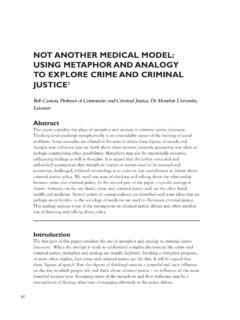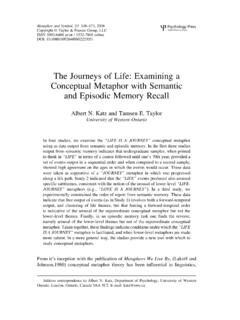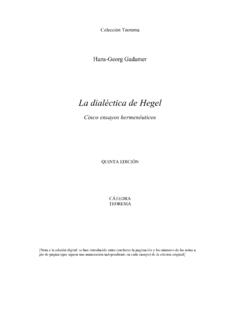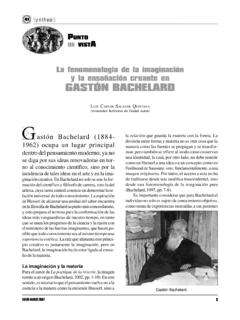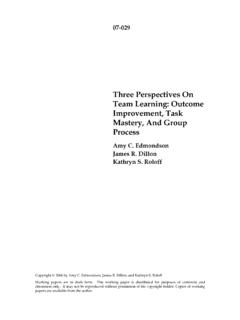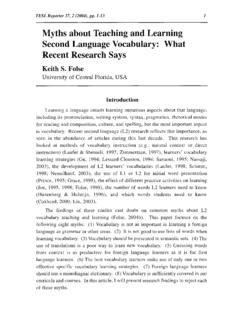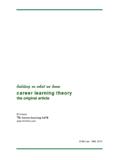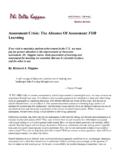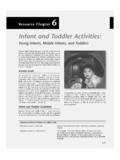Transcription of Applying metaphors for learning to continuing …
1 Applying metaphors for learning to continuingprofessional development (CPD), in the context ofa course for Special Educational NeedsCoordinators (SENCOs)jrs3_1186 Pearson, Phil Scott and David SugdenSchool of Education, University of LeedsKey words: metaphors , continuing professional development, literature suggests that understandings ofteaching and learning can be classified around twometaphors: acquisition and participation. It isfurther argued that neither metaphor is sufficientand that both are on material from a larger study related tothe professional development of Special Educa-tional Needs Coordinators, the paper uses conceptmaps and the associated interviews to explore theunderstandings of the course participants andchanges in their conceptualisation over time.
2 Thedata reveal that individuals do draw on both meta-phors and that their progress can be viewed interms of both acquiring knowledge and alsoprogress from novice to expert. If teaching and learning , and participants progressare viewed in this way, there are implications forcourse development and evaluation. Some of theseare development of teachers is central to inclusiveeducation (Mittler, 2000). This paper is concerned with howmodels of learning and progress can be used to inform andanalyse that process, with empirical evidence drawn fromthe continuing professional development (CPD) for SpecialEducational Needs Coordinators (SENCOs). The firstsection considers understandings of CPD. For the purposesof this paper, the discussion is mainly restricted to formalactivities although the value of informal CPD should not beunder-estimated.
3 The potential of metaphors for learning inunderstanding and developing the formal CPD activities isconsidered, with detailed attention given to Sfard s distinc-tion between acquisition and participation (Sfard, 1998).This leads to an explanation of progress in terms of theevolution from novice to expert, in other words, a concep-tualisation of progress within the Sfard s second section applies these theoretical understandingsto evidence from an award-bearing course for data were gathered from course participants on a PostGraduate Certificate course for teachers and involvedconcept maps and interviews. The evidence suggested thatdevelopment of those attending the course can be under-stood not only in terms of meeting the formal assessmentcriteria but also in terms of progress from novice to expert.
4 Further data that illustrates that the participants make ref-erence to both the metaphors of learning are on existing research about the value of Sfard swork, the third section argues that, if both of these meta-phors are evident, there are implications for course provid-ers in terms of how they plan and deliver courses, and alsohow teachers progress is conceptualised. Although thefocus for this research was an award-bearing course forSENCOs in England, it does draw on evidence from otherforms of professional development. Similarly, this researchhas wider implications for professional developmentbeyond that intended for of the professional developmentof teachersEvidence exists that indicates teachers professional devel-opment is conceptualised in diverse ways.
5 Job specifica-tions frequently include required and/or desirablequalifications gained through award-bearing coursesalthough this approach can be unsatisfactory. Attendance atand successful completing of an award-bearing course isnot necessarily synonymous with professional growth. Forinstance, achieving accreditation may be indicative ofsurface learning rather than deep learning , and further, maynot be associated with any changes in professional prac-tices. Some bodies, such as the Training and DevelopmentAgency (TDA), adopt a different approach, namely seekingevidence of changes in the outcomes for pupils taught bythe attendees. Data of this type are elusive, may only beevident in the medium to long-term, and, if detectable,problematic since simple causal links are, at best, elusiveand probably non-existent.
6 Intractable complications exist Journal of Research in Special Educational Needs Volume 11 Number 1 2011 42 54doi: 2010 The Authors. Journal of Research in Special Educational Needs 2010 NASEN since the relationship between CPD and changes in profes-sional practice is non-linear and complex (Hoban, 2002).Harland and Kinder (1997, p. 77) observed that participantshave a unique outcome route following an in-serviceexperience and rarely achieved exactly the same permuta-tion of outcomes as other colleagues. In summary, although (pre-determined) changes in practiceare often promoted as desirable outcomes of professionaldevelopment, it is well recognised that the consequences ofCPD disparate and individualistic (Harland and Kinder,1997, p. 81), being partly determined by the particularitiesof historical and socio-cultural environment of each teacher(Kelchterman, 2004).
7 In the light of the complexities, this research narrowed thefocus to changes in the course participants own learning , interms of changes in their schema. This term is used to referto a mental representation of the world that involved theorganisation of concepts which may be revised in the lightof new information. The rationale for this focus was thateach participant would have pre-existing schema and thatany modifications would provide evidence of deep learningwhich may occur with or without changes in the schema of each individual captured datathat were not only associated with reported or observablechanges in current professional practice but also the con-ceptualisations that would underpin future changes in pro-fessional practices. The assumption was that changes couldlargely be attributed to course attendance although clearlyother factors such as contact with particular individuals( , a member of the special needs support service or aneducational psychologist or a pupil) may also have played apart.
8 Thus, the course is viewed as the major rather than concerned with the structuring of knowledge,including those studying professional development ofteachers (Hodkinson and Hodkinson, 2004, Saban, 2006),have found metaphors valuable. For example, they provideinsights into the ways in which individuals learn. In thecontext of those formally concerned with learning , such asteachers, the metaphors which individuals access pro-foundly affect [their] thinking about teaching and learning (Martinez, Sauleda and Huber, 2001). Prawat (1999) furtherargued that teachers should be concerned with the meta-phors that they present to learners in a classroom because ofthe implications for learners. In this paper, the significanceof an individual s personal metaphors when they are in therole of learner, when thinking about teaching and learning ,and when providing modelling learning to other have beenapplied to the context of HEI tutors working with metaphors that informed this research were developedby Sfard in whose view the existence of multiple theoriesfor learning created a state of perturbation (Sfard, 1998,p.)
9 4). She sought to classify the established and emergingtheories with a view to providing a bird s eye view thatexposes the tacit assumptions and beliefs that guide us (p. 4). For that process, she argued that metaphors arevaluable since they are the most primitive, most elusive,and yet amazingly informative objects of analysis (p. 4).She argued that their additional power is that they oftencross the borders between the spontaneous and the scien-tific, between the intuitive and the formal (p. 4). In herview, the metaphor adopted will influence the ways ofthinking and the activities reviewing the discourse of learning , she suggested thatthere was evidence of two principle (or root) metaphors oflearning, namely the acquisition metaphor (AM) and the participation metaphor (PM).
10 The differences betweenthese are summarised in Table 1 acquisition metaphor (AM) uses terms such as recep-tion, acquisition, construction, internalisation, appropria-tion, transmission, attainment, development, accumulation,grasp (Sfard, 1998, p. 5), whereas terms such as legitimateperipheral participation (Lave and Wenger, 1991) and apprenticeship (Rogoff, 1990) are associated with the par-ticipation metaphor (PM).Sfard argued that the two metaphors that she identified arenot mutually exclusive: theoretical exclusivity and didacticsingle-mindedness can be trusted to make even the best ofeducational ideas fail ( ). The rejection of exclusivityalso implied a rejection of certainty; the complexities and arbitrary nature of some classifications (Sfard, 1998,p.)
